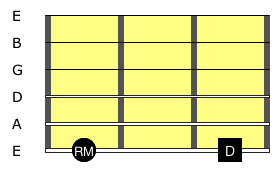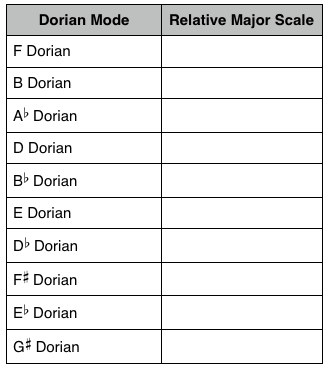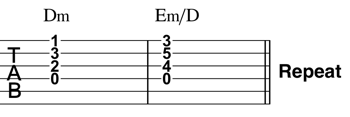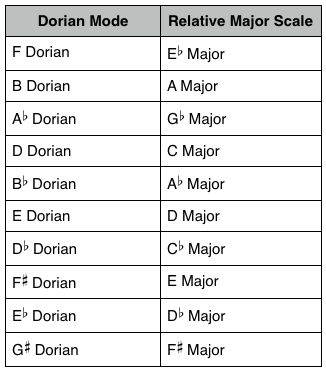In the previous lesson, you learned how to work out the notes of any dorian mode using its musical spelling. In this lesson you’ll be learning about the relative major scales of the dorian mode and, more importantly, how to use them to improve your dorian mode soloing.
Relative Major Scales Of The Dorian Mode
Every dorian mode has a major scale that shares the exact same collection of notes. This is referred to as the relative major scale, and you can see an example of this by checking out the two scales before…
A Dorian Mode:

G Major Scale:

As you can see from the above two staves…
- The A Dorian mode is comprised of the same group of notes as the G Major scale.
- Both of the scales use the same key signature. (1 sharp).
What this means is that the two scales are relative scales. Or put another way…
- A Dorian is the relative dorian mode of the G Major scale.
- The G Major scale is the relative major scale of the A Dorian mode.
Why This Stuff Is Important
Many guitarists think that they need to know specific dorian scale fingerings in order to solo in a dorian mode context. Because they have this belief, this makes them feel that they have to do a lot of work memorising new scale fingerings before they even begin using the dorian mode in their guitar solos.
This is simply not the case…
The great thing about knowing about relative major scales, is that you can get started with soloing with the dorian mode right away. For Example: If you wanted to solo over a backing track that’s in A Dorian, then you could use all of the G Major scale fingerings that you know to solo over that backing track. Obviously, this means that you’ll get up and running with the dorian mode much sooner. Not to mention, you’ll also be having fun with soloing in the dorian mode straight away. 🙂
An Easy Way To Work Out Relative Major Scales
Working our the relative major scale of the dorian mode is dead simple. All you need to do is find the seventh note of the dorian mode key that you want to solo in. By far the easiest way to do this, is to go down a whole-step from the root note of the dorian mode key that you’re in. Here’s an example of what I mean…
D Dorian Mode:

Because the seventh note of the D Dorian mode is C, then this means that the relative major scale is C Major. So if you wanted to solo in the D Dorian mode, you could use any C Major scale fingering that you know.
Rather than working out all the notes of the dorian mode first, I think it’s a good idea to use the following diagram to visualize the relative major scale…

To use this diagram, all you need to do are following two steps…
- Put your third finger on the root note of the dorian mode key that you want to solo in. (I have shown this on the diagram using the box with the D on it). For Example: If you wanted to play a solo in the key of C Dorian, you would put your third finger on the 8th fret of the thick E-string).
- To work out the relative major scale, all you need to do is put your first finger on the note that’s two frets lower than your third finger. (On the diagram above, I’ve used the circle with the RM to indicate this). For Example: Using the example from Step 1, this would mean that your first finger would be at the 6th fret on the thick E-string. (This is a Bb note). This means that the relative major scale of C Dorian is Bb major.
Work Out These Relative Major Scales
Please take the time now to work out the relative major scales for the following dorian modes…

I’ll be giving you the answers after the next section of this lesson. So be sure that you fill out the table before reading any further. I know many people reading this lesson will disregard this sage advice, but I trust you’ll be one of the few diligent guitarists who don’t cheat. 🙂
Putting This Music Theory Into Practice
Now that we’ve talked about the theory, let’s now look at an application exercise that will help you to apply the theory in a musical context. Please do these three steps now…
- Take the time to memorise the following two bar chord progression that’s in the key of D Dorian.

- Record yourself playing the chord progression repeatedly for at least five minutes. (Feel free to use any strumming pattern that you want).
- Using the relative major scale, improvise over the chord progression you’ve just recorded. Because the progression is in D Dorian, then this means you can solo over it using any C Major scale fingering. (If you don’t know any, then you can use the fingering that I’ve included on the next page).
The Answers
Let’s now take a look at the answers for the table that you filled out earlier in the lesson…

A Few Last Words
That’s all for this lesson. Hope you enjoyed it! 🙂 Remember, while learning the theory behind the dorian mode is an interesting intellectual exercise, it’s very important that you do the application exercises that we covered in this lesson and the last lesson. They’ll help you move beyond the theory, and enable you to learn the dorian mode in a practical way that will actually help you to become a better lead guitarist.
Have fun!
Return To: Guitar Music Theory Lessons